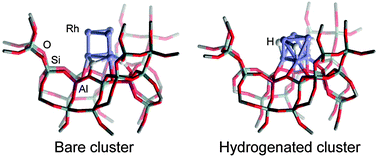Reverse hydrogen spillover on and hydrogenation of supported metal clusters: insights from computational model studies
Abstract
“Reverse” spillover of hydrogen from hydroxyl groups of the support onto supported transition metal clusters, forming multiply hydrogenated metal species, is an essential aspect of various catalytic systems which comprise small, highly active transition metal particles on a support with a high surface area. We review and analyze the results of our computational model studies related to reverse hydrogen spillover, interpreting available structural and spectral data for the supported species and examining the relationship between metal–support and metal–hydrogen interactions. On the examples of small clusters of late transition metals, adsorbed in zeolite cavities, we showed with computational model studies that reverse spillover of hydrogen is energetically favorable for late transition metals, except for Au. This preference is crucial for the chemical reactivity of such bifunctional catalytic systems because both functions, of metal species and of acidic sites, are strongly modified, in some cases even suppressed – due to partial oxidation of the metal cluster and the conversion of protons from acidic hydroxyl groups to hydride ligands of the metal moiety. Modeling multiple hydrogen adsorption on metal clusters allowed us to quantify how (i) the support affects the adsorption capacity of the clusters and (ii) structure and oxidation state of the metal moiety changes upon adsorption. In all models of neutral systems we found that the metal atoms are partially positively charged, compensated by a negative charge of the adsorbed hydrogen ligands and of the support. In a case study we demonstrated with calculated thermodynamic parameters how to predict the average hydrogen coverage of the transition metal cluster at a given temperature and hydrogen pressure.


 Please wait while we load your content...
Please wait while we load your content...